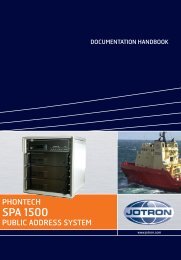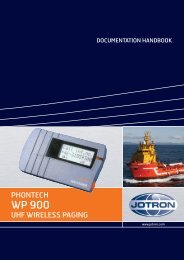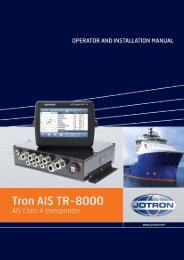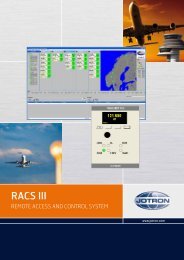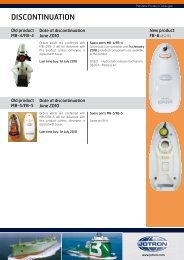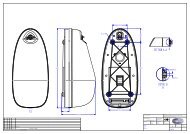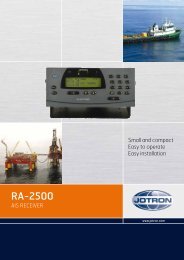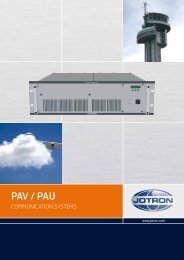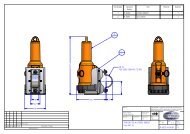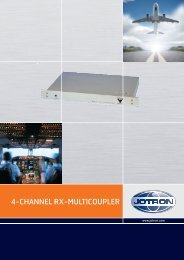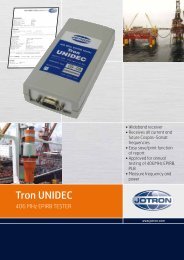Users Manual Tron 40GPS.pdf - Jotron
Users Manual Tron 40GPS.pdf - Jotron
Users Manual Tron 40GPS.pdf - Jotron
Create successful ePaper yourself
Turn your PDF publications into a flip-book with our unique Google optimized e-Paper software.
<strong>Tron</strong> <strong>40GPS</strong><br />
USERS MANUAL<br />
www.jotron.com
99743_UM_<strong>40GPS</strong>_D
REVISION HISTORY<br />
CHANGES RECORD NO. CHAPTER VERSION<br />
NEW MANUAL EM3829 – A<br />
NEW TEXT EM3903 5 B<br />
NEW TEXT EM3944 1.6, 3.1, 4.1, 5, 5.1, 5.2, 5.7, 6.1, FIG. 5 C<br />
NEW TEXT EM3980 1.1, 3.2, 6, FIG 4, FIG 6, FIG 7 D<br />
99743_UM_<strong>40GPS</strong>_D<br />
3
TABLE OF CONTENTS<br />
Glossary ...............................................................5<br />
Battery Safety Data Sheet ................................6<br />
Radio Log Instructions ......................................7<br />
Test of radio equipment ...............................7-8<br />
Test and Maintenance Record ........................9<br />
1. INTRODUCTION ......................................10<br />
1.1 General ........................................................10<br />
1.2 System Description ..................................11<br />
1.3 Signal Detection ........................................11<br />
1.4 Distress Location Determination ........12<br />
1.5 Added value.................................................12<br />
1.6 EPIRB Registration ...................................12<br />
2.TECHNICAL SPECIFICATIONS .............13<br />
2.1 General ........................................................13<br />
2.2 Cospas/Sarsat Transmitter ......................13<br />
2.3 Homing Transmitter .................................14<br />
2.4 Brackets .......................................................14<br />
2.5 Added value ............................................... 14<br />
3. OPERATING INSTRUCTIONS ..............14<br />
3.1 <strong>Manual</strong> Operation ....................................15<br />
3.2 Automatic Operation ..............................15<br />
3.3 Testing the <strong>Tron</strong> <strong>40GPS</strong> ...........................15<br />
4.TECHNICAL DESCRIPTION<br />
EPIRB TRON <strong>40GPS</strong> ................................16<br />
4.1 Features .......................................................16<br />
4.2 Storage ........................................................16<br />
5. MAINTENANCE .........................................17<br />
5.1 Replacing the Release Mechanism ........18<br />
5.2 Replacing the Battery Unit .....................18<br />
5.3 Battery disposal .........................................19<br />
6.ACCESSORIES<br />
BRACKETS .................................................20<br />
6.1 Float free Bracket FB5/FB4 ....................20<br />
6.2 Float free Bracket FBH4 .........................20<br />
6.3 <strong>Manual</strong> Bracket MB5/MB4 ......................20<br />
6.4 Mounting the Brackets ............................20<br />
FIGURES<br />
Fig.1 Functional Drawing ..............................21<br />
Fig.2 <strong>Manual</strong> operation ..................................22<br />
Fig.3 Automatic operation ............................23<br />
Fig.4 Self Test ....................................................23<br />
Fig.5 Mounting of Hydrostatic ....................24<br />
Fig.6 Replacing the Battery Unit ........24 - 26<br />
Fig.7 Mounting of Brackets ..........................26<br />
NOTES ......................................................27 - 28<br />
MARINE SERVICE AGENTS ...............29 – 35<br />
4<br />
4<br />
99743_UM_<strong>40GPS</strong>_D
GLOSSARY<br />
C O S P A S<br />
COsmicheskaya Sistyema Poiska Avariynich Sudov<br />
(Space System for the Search of Vessels in Distress)<br />
S A R S A T<br />
Search and Rescue Satellite-Aided Tracking System<br />
EPIRB Emergency Position Indicating Radio Beacon<br />
LUT Local User Terminal (Ground Station)<br />
MCC Mission Control Center<br />
RCC Rescue Coordination Center<br />
km kilometer<br />
MHz Mega-Hertz (10 6 Hertz)<br />
GPS Global Position System<br />
99743_UM_<strong>40GPS</strong>_D<br />
5
BATTERY SAFETY DATA SHEET<br />
(Form: EEC directive 91/155)<br />
( 2 ) S A F E T Y A D V I C E<br />
S2 Keep out of reach from children.<br />
S8 Keep container dry.<br />
S26 In case of contact with eyes, rinse immediately with<br />
plenty of water and seek medical advice.<br />
S43 In case of fire, use D type extinguishers. Never use water.<br />
S45 In case of accident or if you feel unwell, seek medical<br />
advice immedately (show the label where possible).<br />
( 3 ) F I R S T A I D M E A S U R E S<br />
In case of contact of cell contents with eyes, flush immediately<br />
with water for 15 min.With skin, wash with plenty of water and<br />
take off contaminated clothes. If inhalation, remove from exposure,<br />
give oxygen, seek medical advice.<br />
( 4 ) F I R E - F I G H T I N G M E A S U R E S<br />
Extinguishing media<br />
Suitable: Type D fire extinguishers<br />
Not to be used: Water - CO 2 - Halon, dry chemical or foam<br />
extingiushers<br />
Special exposure hazards<br />
Generation of chlorine, sulfur dioxide, disulfur dichloride during<br />
thermal decomposition.<br />
Special protective equipment<br />
Use protective working boots, rubber apron and safety glasses<br />
with side shields.<br />
6<br />
99743_UM_<strong>40GPS</strong>_D
I N S T R U C T I O N S F O R K E E P I N G T H E R A D I O L O G A N D<br />
T H E R A D I O O P E R A T O R S O B L I G A T I O N A C C O R D I N G<br />
T O N A T I O N A L A N D I N T E R N A T I O N A L R E G U L A T I O N .<br />
1. The radio log shall be kept in accordance with requirements in the Radio<br />
Regulations, SOLAS Convention, national regulations regarding radio installations<br />
and the STCW Convention (STCW 95 including the STCW Code) including<br />
relevant regulation regarding watchkeeping on board passenger- and cargo ships.<br />
2. Unauthorized transmissions and incidents of harmful interference should,<br />
if possible, be identified, recorded in the radio log and brought to the attention<br />
of the Administration in compliance with the Radio Regulations, together with<br />
an appropriate extract from the radio log. (STCW Code B-VIII/2 No.32)<br />
T E S T O F R A D I O E Q U I P M E N T A N D R E S E R V E S O U R C E O F E N E R G Y<br />
Weekly:<br />
GMDSS handheld VHF transceivers to be tested without using the mandatory<br />
required emergency batteries.<br />
Monthly:<br />
Float-free and manual EPIRBs to be checked using the means provided for testing on the<br />
equipment. Check data for periodical maintenance requirement for float-free EPIRB.<br />
Search and rescue radar transponders (SART) to be checked against 9 GHz radar.<br />
Float-free EPIRBs are required to go through a periodical maintenance<br />
every 24 months. (Only for NOR/NIS flag vessels).<br />
False alerts transmitted by EPIRB<br />
False alerts are a serious problem for the rescue service. Nearly 90% of EPIRB<br />
initiated distress alerts turn out to be false alarms.<br />
If for any reason, your EPIRB should cause a false alarm, it is most important that you<br />
contact the nearest search and rescue authority and tell them it was a false alarm. They<br />
can then stand down any rescue service (coast radio station or appropriate CES or<br />
RCC). Use any means at your disposal to make contact. Switch off the distress alarm<br />
by de-activating your EPIRB, as soon as possible.<br />
99743_UM_<strong>40GPS</strong>_D 7
If your beacon is activated in a non-distress situation or a distress situation which has<br />
been resolved and you no longer require assistance, contact the nearest search and<br />
rescue authorities via the most expeditious means available with the following<br />
information:<br />
Beacon ID number (15 character UIN):<br />
Position (At time of activation):<br />
Date of Activation:<br />
Time of Activation (Time zone):<br />
Duration of Activation:<br />
Beacon marke and model:<br />
Vessel Name/lD:<br />
Circumstances/cause (if known):<br />
The United States search and rescue authority is the U.S. Coast Guard.<br />
The primary points of contact are:<br />
Pacific Ocean Area<br />
USCG Pacific Area Command Centre<br />
Tel: (510)-437-3701<br />
Atlantic Ocean / Gulf of Mexico Area<br />
USCG Atlantic Area Command Centre<br />
Tel: (757)~398-6231<br />
From Any Location<br />
USCG Headquarters Command Centre<br />
Tel: (800)-323-7233<br />
8<br />
99743_UM_<strong>40GPS</strong>_D
TEST AND MAINTENANCE RECORD<br />
DATE N/T/B SIGN INSP<br />
99743_UM_<strong>40GPS</strong>_D<br />
N=NEW EPIRB INSTALLED,T=TEST, B=NEW BATTERY<br />
9
1. INTRODUCTION<br />
1 . 1 G E N E R A L<br />
The <strong>Tron</strong> <strong>40GPS</strong> is an emergency equipment consisting of:<br />
• <strong>Tron</strong> <strong>40GPS</strong> COSPAS/SARSAT emergency EPIRB<br />
• One of the following brackets:<br />
FB4 - Automatic float free bracket.<br />
FBH4 - Automatic float free bracket v/heating.<br />
MB4 - <strong>Manual</strong> bracket.<br />
MB5 - <strong>Manual</strong> bracket<br />
FB5 - Automatic float free bracket.<br />
The JOTRON <strong>Tron</strong> <strong>40GPS</strong> EPIRB is developed to meet the regulations and rules<br />
for use on vessels and life rafts in the maritime service.<strong>Tron</strong> <strong>40GPS</strong> meets the<br />
following specifications for 406 MHz EPIRBs for use in search and rescue operations<br />
at sea:<br />
ETS 300 066<br />
MPT 1259<br />
C/S T.001<br />
IMO A662<br />
IMO A695 (17){1}<br />
IMO A810 (19)<br />
DIR 96/98 EEC<br />
The <strong>Tron</strong> <strong>40GPS</strong> is buoyant, and is designed to automatically release and activate in<br />
case of an emergency where the EPIRB and its bracket is submerged into the sea.The<br />
<strong>Tron</strong> <strong>40GPS</strong> can also be operated as a manual EPIRB, by manually releasing it from its<br />
bracket and then activate it.<br />
Five different brackets are currently available for the <strong>Tron</strong> 40S. MB4and MB5 is the<br />
manual bracket and FB4 and FBH4 is automatic bracket. FB5 is automatic bracket<br />
with cover. The manual bracket comes without the hydrostatic release mechanism<br />
and is used to store the beacon inside the wheelhouse or other protected places.<br />
The automatic bracket is mounted in a free space outside where the beacon can be<br />
released automatically.<br />
The purpose of the <strong>Tron</strong> <strong>40GPS</strong> is to give a primary alarm to the search and rescue<br />
authorities.The EPIRB gives an immediate alarm when activated, transmitting the ID<br />
of the ship in distress. Care must be taken not to activate the EPIRB unless in an<br />
emergency situation, in such cases the user will be held responsible. For periodic<br />
testing a test function is implemented. During the test cycle the EPIRB does a selftest<br />
on the transmitters and on the battery status. No emergency signal is transmitted<br />
during the selftest.<br />
The battery of the EPIRB will last for at least 48 hours from activation of the EPIRB.<br />
10<br />
0 99743_UM_<strong>40GPS</strong>_D
1 . 2 S Y S T E M D E S C R I P T I O N<br />
The COSPAS/SARSAT system was introduced in 1982 as a world wide search<br />
and rescue system with the help of satellites covering the earth’s surface. Since<br />
the introduction of the system more than 5500 persons have been rescued by<br />
the COSPAS/SARSAT system (June 1995). Currently the system consists of 6<br />
different satellites in a polar orbit constellation, these satellites cover the<br />
entire earth’s surface and receive the emergency signal from the 406 MHz<br />
transmitter within the <strong>Tron</strong> <strong>40GPS</strong>, more polar orbiting satellites will be available<br />
in the future, giving a faster location and rescue time.<br />
In addition several geostationary satellites are equipped with a 406 MHz transponder,<br />
these satellites are not able to locate the <strong>Tron</strong> <strong>40GPS</strong> but will give an<br />
early warning to the rescue forces, minimising the time from an emergency<br />
occurs till the rescue forces are at the site.<br />
Each emergency EPIRB in the system is programmed with its own unique<br />
code, therefore it is vital that the ships data that is given to the dealer you<br />
obtained your <strong>Tron</strong> <strong>40GPS</strong>, is correct. It is also important that your EPIRB is<br />
registered in the database for each country.This database is normally located<br />
in the same country that the ship is registered.<br />
1 . 3 S I G N A L D E T E C T I O N [ F I G . 1 ]<br />
When the <strong>Tron</strong> <strong>40GPS</strong> is activated (manually or automatically) it transmits<br />
on the frequencies 121.5 MHz and 406.025 MHz.An analogue signal is emitted on<br />
121.5 MHz and a digital signal is transmitted on 406.025 MHz. After the <strong>Tron</strong><br />
<strong>40GPS</strong> is activated, the next passing satellite will detect the transmitted signal and<br />
relay it to an antenna at a ground station, called a LUT.<br />
For the 121.5 MHz signal the satellite must be within line of sight of both the<br />
<strong>Tron</strong> <strong>40GPS</strong> and a ground station.The ground station or LUT has a 2500 km<br />
satellite reception radius centred at the LUT. In areas without LUT coverage<br />
(mostly less populated areas in the southern hemisphere), signals from the<br />
121.5 MHz transmitter will not be detected by the satellites, only by passing<br />
aircraft’s.This is not the case with the 406 MHz transmitter, because the satellites<br />
have a memory unit which stores the signals for relay to the next available<br />
LUT giving it a truly global coverage.<br />
Once the signal is received by the LUT, it is processed for location and sent to<br />
a Mission Control Centre (MCC).The MCC sorts the alert data according to<br />
geographic search and rescue regions and distributes the information to the<br />
appropriate Rescue Co-ordination Centre (RCC), or if outside the national<br />
search and rescue area, to the appropriate MCC that covers the area where<br />
the distress signal was detected.The RCC in turn takes the necessary action<br />
to initiate search and rescue activities.<br />
99743_UM_<strong>40GPS</strong>_D<br />
11
1 . 4 D I S T R E S S L O C A T I O N D E T E R M I N A T I O N<br />
The location of the distress signal is determined by taking measurements of the<br />
doppler shift of the EPIRB frequency when the satellite first approach and then<br />
pass the EPIRB. The actual frequency is heard at the time of closest approach<br />
(TCA). Knowing the position of the satellite and using the received doppler<br />
signal information, it is possible to determine the location of the <strong>Tron</strong> <strong>40GPS</strong><br />
from the satellite at the TCA.At the LUT, actually two positions are calculated.<br />
One is the actual position (A) and the other is the mirror image (B) position.A<br />
second satellite pass confirms the correct location (A).With the 406 system the<br />
real solution can be determined on the first pass with a reliability of nearly 90%<br />
and down to an accuracy of less than 5 km (3.1 miles).<br />
1 . 5 A D D E D VA LU E I N T R O N 4 0 G P S<br />
The <strong>Tron</strong> <strong>40GPS</strong> has been designed to operate with the COSPAS-SARSAT<br />
system and will enhance further the lifesaving capabilities of conventional<br />
beacons.The integrated 12 channel GPS module accept continuous positional<br />
information from the standard GPS system using 27 satellites providing an accuracy<br />
of approximately 100m. Upon activation of the <strong>Tron</strong> <strong>40GPS</strong> in an emergency<br />
situation the positional information is incorporated into the distress message<br />
transmitted to LUT.The main advantage with integrated GPS in <strong>Tron</strong> <strong>40GPS</strong> is<br />
the rapid response and positional accuracy providing vital information during a<br />
rescue operation practically eliminating valuable time spent searching for the<br />
distressed.Whenever a distress message transmitted by <strong>Tron</strong> <strong>40GPS</strong> is detected<br />
by a polar orbit satellite (LEOSAR) the delayed alert remains the same as for<br />
non-GPS integrated EPIRBS (max. 90 min.), but the position accuracy is improved<br />
considerably from a radius of 5 km. to amazing 100m.Whenever a distress<br />
message transmitted by <strong>Tron</strong> <strong>40GPS</strong> is detected by geostationary satellite<br />
(GEOSTAR) the alert is immediate (max. 5 min.), still providing the accurate position<br />
of 100m. Please note that the positional accuracy delay is depending on the<br />
actual protocol used and programmed into the EPIRB and the location of the<br />
emergency.The information is based on the capacity of the LEOSAR/GEOSAR<br />
COSPAS-SARSAT system.<br />
1 . 6 E P I R B R E G I S T R A T I O N<br />
Normally the MCC will contact the vessel or the contact person registered in a<br />
shipping register and/or an EPIRB register (Ships owner, family member etc.)<br />
before alerting the RCC.This is to determine if the alarm from the EPIRB for<br />
some reason is a false alarm, and an expensive rescue operation can be avoided.<br />
Because of this it is important that the ships data is correct in the shipping<br />
register or in the EPIRB database.<br />
<strong>Tron</strong> <strong>40GPS</strong> purchased in some countries will have a registration form attached<br />
to it, it is important that this registration form is completed by the owner and<br />
returned to the place the EPIRB was purchased or to the address specified on<br />
the registration form.<br />
12<br />
99743_UM_<strong>40GPS</strong>_D
Other countries use the already available shipping register to obtain the necessary<br />
information for a vessel in distress, in these countries the ship is already<br />
registered and no registration form is necessary, however it is vital that the<br />
coding of the <strong>Tron</strong> <strong>40GPS</strong> is kept up to date with datas on the ship (nationality,<br />
call sign, etc.), to minimise the time from an alarm to the start of the search and<br />
rescue operation. Reprogramming the <strong>Tron</strong> <strong>40GPS</strong> can be done at authorised<br />
JOTRON agents in more than 180 different places throughout the world.<br />
If you are a resident of the United States, you must register this beacon with the<br />
National Oceanic and Atmospheric Administration (NOAA) using the registration<br />
card included with the unit. Fill out the form and send it to:<br />
SARSAT Beacon Registry, NOAA-SARSAT, E/SP3, FB4, Room 3320,<br />
5200 Auth Road, Suitland, MD 20746-4304<br />
Vessel owners shall advise NOAA in writing upon change of vessel or EPIRB<br />
ownership.Transfer of EPIRB to another vessel, or any other change in registration<br />
information, NOAA will provide registrants with proof of registration and<br />
change of registration postcards.<br />
2. TECHNICAL SPECIFICATIONS<br />
2 . 1 G E N E R A L<br />
Item: Description:<br />
Battery: Lithium, 4 years service life.<br />
Housing: Polycarbonate w/ 10% glassfibre<br />
Dimensions: Height: 379 mm<br />
Max diameter: 180 mm<br />
Weight app:. 2.0 kg<br />
Materials: Polycarbonate.<br />
Compass safe distance: 1.5 m<br />
Temperature range: -20 o C to + 55 o C<br />
Operating life: Minimum 48 hours at -20 o C<br />
2 . 2 C O S P A S / S A R S A T T R A N S M I T T E R<br />
Item: Description:<br />
Frequency: 406.025 MHz - + 2 ppm<br />
Output power: 5W - + 2 dB<br />
Protocols: <strong>Tron</strong> 40S: Maritime, Serialised, Radio Callsign<br />
Protocols:<br />
Modulation:<br />
<strong>Tron</strong> <strong>40GPS</strong>: Standard Location, User Location<br />
Phase modulation 1.1 - + Data encoding:<br />
0.1 rad<br />
Bi Phase L<br />
Stability: Short term < -9 - 10<br />
Medium term < -9 - 10<br />
Residual noise < -9 - 3x10<br />
Bitrate: 400 b/s<br />
Antenna: Built in, omnidirectonal.<br />
99743_UM_<strong>40GPS</strong>_D<br />
133
2 . 3 H O M I N G T R A N S M I T T E R<br />
Frequency: 121.500 MHz<br />
Output power: Up to 100 mW,<br />
depending on model.<br />
Modulation: A9,AM sweep tone from max.<br />
1600 Hz downto min. 300 Hz.<br />
Sweep range 700 Hz.<br />
Sweep rate 2.5 Hz.<br />
Stability: 10 ppm over temperature range.<br />
Antenna: Built in, omnidirectional.<br />
2 . 4 B R A C K E T S<br />
Materials: Luran S<br />
Dimensions: length: 422 mm<br />
Width: 209 mm<br />
Depth w/Beacon intalled: 200 mm<br />
Weight: app 1.6 kg<br />
Release mechanism: Hydrostatic release<br />
unit Hammar H20<br />
with <strong>Jotron</strong> special bolt<br />
2 . 5 A D D E D V A L U E I N T R O N 4 0 G P S<br />
GPS receiver: 12 channels, GPS module.<br />
Freq. 1575.42MHz.Time to first fix<br />
(TTFT)
3 . 1 M A N U A L O P E R A T I O N [ F I G . 2 ]<br />
Warning<br />
99743_UM_<strong>40GPS</strong>_D<br />
USE ONLY DURING SITUATIONS<br />
OF GRAVE AND IMMINENT DANGER<br />
For operation of the beacon in the bracket please follow instructions 1 to 6.<br />
To manually remove the beacon from the bracket, pull out the locking pin on the<br />
clamp and open the retaining rod that holds the beacon.<br />
Tie the beacon lanyard to you or to the survival craft and then follow instructions 1<br />
to 6, or put beacon in the water to activate it. It is not recommended to operate the<br />
beacon inside a liferaft or under a cover or canopy. Do NOT tie the lanyard to the<br />
ship in distress, as this will prevent the unit to functioning if the ship sinks.<br />
1. Break the seal and pull the locking pin holding the main activator switch.<br />
2. Push slider to move switch to ON/EMERGENCY position.<br />
3.The switch is spring loaded and will automatically go to the<br />
ON/EMERGENCY position.<br />
4.The LED indicator, located at the top of the EPIRB, will start flashing<br />
indicating that the EPIRB is operating. In addition the strobe light will start to<br />
operate.The LED indicator will turn off after a few seconds.<br />
5. If possible keep the EPIRB in an open area, away from any metal objects (ship<br />
construction etc.) that may limit the satellite coverage.<br />
6.Transmission can be stopped by turning the switch to READY position.<br />
3 . 2 A U T O M A T I C O P E R A T I O N ( F B 4 / F B H 4 / F B 5 ) [ F I G . 3 ]<br />
1.The <strong>Tron</strong> <strong>40GPS</strong> will automatically release from the bracket, float to the surface<br />
and start to transmit, when the EPIRB in its bracket is deployed into water at a<br />
depth of app. 2-4 meters (6 - 13 feet).<br />
2.Alternatively the EPIRB can be manually released from the bracket and put into the<br />
water.<br />
3.Transmission will continue until the EPIRB is lifted out of the water, and dried off.<br />
The transmission can also be stopped by placing the EPIRB in the bracket.<br />
3 . 3 T E S T I N G T H E T R O N 4 0 G P S [ F I G . 4 ]<br />
To perform the self test, the EPIRB has to be removed from the bracket.<br />
1. Press the spring-loaded switch on top of the EPIRB to the TEST position. Keep<br />
hands and other objects away from the upper part of the EPIRB (away from the<br />
antenna).<br />
2.A successful test will consist of a series of blinks on the LED test-indicator,<br />
followed by a continuous light and a strobe flash after app. 15 seconds.<br />
15
3. If the EPIRB fail to end up with a continuous light, this indicates a fault in the EPIRB.<br />
4. Release the switch and put the EPIRB back into the bracket.What the self test actually<br />
does is first to wait app. 15 seconds to allow the reference oscillator inside the<br />
EPIRB to warm up.Then a short burst is transmitted by the 121.5 MHz transmitter,<br />
while the output level of the transmitter is checked. Finally, a test signal is transmitted<br />
by the 406 transmitter. During this test signal the battery voltage, output power and<br />
frequency is checked.<br />
While testing the 406 MHz transmitter a test message is transmitted, this test message<br />
is coded with a special synchronisation code and will not be detected by the COSPAS/<br />
SARSAT satellites.The purpose of this test message is to control the actual coding of<br />
the EPIRB.This can be done with the JOTRON test unit <strong>Tron</strong>DEC/UniDeck or an other<br />
EPIRB checker.<br />
4. TECHNICAL DESCRIPTION EPIRB TRON <strong>40GPS</strong><br />
4 . 1 F E A T U R E S<br />
• Watertight:<br />
<strong>Tron</strong> <strong>40GPS</strong> is watertight to a depth of minimum 10 meter.<br />
• Buoyant:<br />
<strong>Tron</strong> <strong>40GPS</strong> is buoyant .<br />
• Rugged design:<br />
The <strong>Tron</strong> <strong>40GPS</strong> will withstand a drop from 30 meters into the water.<br />
It is resistant to seawater, oil and sunlight.<br />
• Handling:<br />
The <strong>Tron</strong> <strong>40GPS</strong> is made for easy operation, with a brief operating<br />
instruction printed on the unit.<br />
It comes standard with a 20 meter rope that can be attached to the liferaft.<br />
• Indicators:<br />
The <strong>Tron</strong> <strong>40GPS</strong> is equipped with a LED and a built in strobe light to show operation<br />
of the EPIRB.<br />
The strobe light and LED will normally flash with a frequency of 20 per minute to<br />
show that the EPIRB is activated.<br />
4 . 2 S T O R A G E<br />
The EPIRB is normally stored in its bracket.The bracket contains means to prevent accidental<br />
activation of the EPIRB.The bracket should be mounted<br />
in a place that is easily available for periodic testing, and a place which is easily accessible<br />
in case an emergency situation occur.<br />
16<br />
99743_UM_<strong>40GPS</strong>_D
5. MAINTENANCE OF JOTRON EPIRBS<br />
Every Month:<br />
Perform EPIRB self-test. (See chapter 3.3.). What the self test actually does is to<br />
send out a short test signal on 121,5 and 406,025 Mhz, testing the output of the<br />
transmitter.While transmitting the test signal, the battery voltage, output power and<br />
phase lock is tested. During the test of the 406Mhz transmitter a test message is<br />
transmitted, this test message is coded with a special synchronisation code and will<br />
not be recognized as real alert by the COSPAS/SARSAT satellites.<br />
Carry out visual inspection for defects on both the EPIRB and Bracket.The EPIRB<br />
should be easily removed and replaced in the Bracket. Make sure that the EPIRB<br />
and Bracket is not painted or otherwise covered with chemicals, oil, etc. Check the<br />
expiry date of the EPIRB Battery and the Hydrostatic Release Mechanism. Check<br />
the presence of a firmly attached lanyard in good condition and that it is neatly<br />
stowed and is not tied to the vessel or the mounting bracket.<br />
Every 12 th Month:<br />
Perform extended annual test according to IMO’s MSC/Circ.1040 (Annual testing of<br />
406 MHz satellite EPIRBs) as required by SOLAS IV/15.9.This test can be carried<br />
out by one of <strong>Jotron</strong>’s authorised representatives or any other service provider in<br />
possession of a <strong>Tron</strong> UNIDEC,<strong>Tron</strong> DEC or any other Cospas-Sarsat EPIRB<br />
tester/decoder.The test ensures that the EPIRB is within its specifications and<br />
complies with IMO and the COSPAS/SARSAT system. Documented proof of test or<br />
Test Certificate containing test results and EPIRB data issued by service provider<br />
must be kept on board for future inspections the next 12 months.<br />
Every 2 nd Year:<br />
Hydrostatic Release Mechanism including Plastic Bolt on the Float Free Brackets<br />
must be replaced. (Check expiry date on label).<br />
Every 4 th Year:<br />
The EPIRB Battery must be replaced every 4th year, unless otherwise instructed by<br />
the vessel flag state or local authorities.(Check expiry date on label).<br />
NOR/NIS flag vessels are required to go through periodical maintenance every<br />
24 months by replacing the complete EPIRB.<br />
99743_UM_<strong>40GPS</strong>_D<br />
177
<strong>Tron</strong> <strong>40GPS</strong> self test:<br />
• Remove the beacon from the bracket.<br />
• Press the springloaded main switch of the EPIRB to the TEST position. Keep hands<br />
and other objects away from the upper part of the EPIRB (away from the antenna).<br />
• A successful test will consist of a series of blinks on the LED testindicator, followed<br />
by a continuous light and a strobe flash after app. 15 seconds.<br />
• If the EPIRB fail to end up with a continuos light, this indicates a fault in the EPIRB.<br />
• Release the switch and put the EPIRB back into the bracket.<br />
Note:The EPIRB can not transmit while placed in the bracket.This feature is built in to<br />
prevent false alarms. (Except U.S version/model).<br />
Please find further information in the Operators <strong>Manual</strong>.<br />
5 . 1 R E P L A C I N G T H E R E L E A S E M E C H A N I S M [ F I G . 5 ]<br />
Hydrostatic unit.<br />
The hydrostatic unit fitted on the float free bracket (FB4/FBH4) must be replaced<br />
every 2. year. Marking on the hydrostatic unit show the expiry dateThe hydrostatic<br />
comes complete with a new bolt and accessories.<br />
1. Remove the EPIRB from its bracket by pulling out the locking pin on the clamp and<br />
open the retaining rod that holds the beacon.<br />
2. Unscrew the plastic bolt [FIG 5] (1) by screwing it counter clockwise and remove the<br />
hydrostatic release mechanism [FIG 5] (2).<br />
3. Check expiration date on the new hydrostatic release mechanism.The date should<br />
be approximately 2 years from the date of purchase.<br />
4. Mount the new hydrostatic release mechanism. The unit is fixed to the bracket with<br />
a plastic bolt containing washer, rubber seal, washer, O-ring.<br />
5. Secure the plastic bolt by hand force only!<br />
5 . 2 R E P L A C I N G T H E B A T T E R Y U N I T [ F I G . 6 ]<br />
The battery unit consists of the complete lower half of the <strong>Tron</strong> <strong>40GPS</strong> and is to<br />
be replaced every 4. year.The marking on the battery unit show the expiry date.<br />
A new battery comes complete and is easily replaced by opening the equator ring<br />
between the top and bottom of the EPIRB.<br />
The battery must be replaced if the EPIRB is activated for any purpose other than test.<br />
Replacing the battery unit should be done by skilled technicians only - preferable by<br />
a JOTRON agent.Your closest JOTRON agent with <strong>Tron</strong>STAT facilities has been specially<br />
trained to perform the necessary operation and is also able to do an extended test<br />
of the EPIRB, ensuring that the EPIRB operates within the specifications.<br />
18<br />
99743_UM_<strong>40GPS</strong>_D
1. Remove the EPIRB from its bracket (chapter5.1.1).<br />
2. Remove the equator ring by pressing it out from the housing.<br />
3. Separate the two halves of the EPIRB housing.<br />
4. Unplug the 6 pin connector that comes from the lower EPIRB housing.<br />
5. Control that the new battery unit is marked with p/n 97780 and has<br />
a new expiration date approximately 4 years from purchase.<br />
6. Fit a new gasket on top of the battery unit and reconnect the 6 pin connector, be<br />
sure that the connector is fitted properly.A noticeable «click» should be heard<br />
when the connector is in place.<br />
7. Orientate the two halves of the EPIRB the following way:<br />
An orientation tab is fitted on both halves of the EPIRB,These tabs must be placed<br />
carefully on top of each other.<br />
8. Make sure that the gasket is properly in place, and replace the equator ring using a<br />
special tool to tighten it together.<br />
9. Replace the U-shaped bolt and a new split pin to secure the bolt in the equator ring.<br />
10. Follow the procedure in chapter 3.3 and test the EPIRB.<br />
11. Replace EPIRB in its bracket.<br />
5.3 BATTERY DISPOSAL<br />
Dispose in accordance with applicable regulations which vary from country to country.<br />
(In most countries, the thrashing of used batteries is forbidden and the end-users are<br />
invited to dispose them properly, eventually through non profit organizations, mandated<br />
by local governments or organized on a voluntary basis by professionals).<br />
Lithium batteries should have their terminals insulated prior to disposal.<br />
5.3.1 Incineration: Incineration should never be performed by battery users<br />
but eventually by trained professionals in authorized<br />
facilities with proper gas and fumes treatment.<br />
5.3.2 Landfilling: Leachability regulations (mg/l)<br />
Component Leachability EC limit EPA Other*<br />
Iron 100 5<br />
Nickel 100 500 2 0,5<br />
* applicable to France<br />
5.3.3 Recycling:<br />
Send to authorized recycling facilities, eventually through licensed waste carrier.<br />
99743_UM_<strong>40GPS</strong>_D<br />
19<br />
9
6. ACCESSORIES<br />
BRACKETS<br />
Five different brackets are currently available for the <strong>Tron</strong> <strong>40GPS</strong>. MB5 and MB4 are the<br />
manual brackets. FB5, FB4 and FBH4 are the automatic brackets. The manual brackets<br />
comes without the hydrostatic release mechanism and is used to store the beacon inside<br />
the wheelhouse or other protected places. The automatic brackets are mounted in a free<br />
space outside where the beacon can be released automatically.<br />
MB5 and FB5 are delivered with protective cover.<br />
6 . 1 F L O A T F R E E B R A C K E T F B 5 A N D F B 4<br />
WARNING:<br />
DO NOT INSTALL THE EPIRB NEAR STRONG<br />
MAGNETIC FIELDS THAT COULD ACTIVATE THE BEACON.<br />
When the <strong>Tron</strong> <strong>40GPS</strong> is mounted in the float-free bracket, FB5 or FB4, it will operate as an<br />
automatic float free unit. Since the release of the EPIRB will be automatic it is important to<br />
mount the bracket in a place where there are no obstacles that can endanger the automatic<br />
release of the EPIRB.The location where the bracket is mounted should be as high as<br />
possible on the vessel, and well protected from environmental conditions such as direct seaspray,<br />
chemicals, oil, exhaust and vibrations.The location must also be easily accessible for<br />
testing and maintenance.<br />
6 . 2 F L O A T F R E E B R A C K E T F B H 4<br />
The float free bracket FBH4 must be connected<br />
to the fixed installation (230V AC, 10A) through<br />
the thermostate connection box according to the<br />
connection diagram below.<br />
C O N N E C T I O N D I A G R A M<br />
230V AC, 10A<br />
HEATING ELEMENT<br />
THERMOSTATE<br />
6 . 3 M A N U A L B R A C K E T M B 5 A N D M B 4<br />
When the <strong>Tron</strong> <strong>40GPS</strong> is mounted in the MB5 or MB4 bracket, it will operate as a manual<br />
unit.This bracket is similar to the FB5 and FB4 bracket but does not have the hydrostatic<br />
release mechanism.This bracket is typically used to store the EPIRB inside the wheel house<br />
or other protected areas of the ship.When the <strong>Tron</strong> <strong>40GPS</strong> is mounted in the MB5 or MB4<br />
bracket, it must be manually removed before any operation can take place, therefore the<br />
bracket should be mounted in an easily accessible place where it can be reached in a hurry<br />
in case of an emergency.<br />
6 . 4 M O U N T I N G T H E F B 5 / M B 5 / F B 4 / F B H 4 / M B 4 B R A C K E T S [ F I G . 7 ]<br />
The bracket is mounted with 4x6mm bolts according to the drawing. Use the bolts supplied<br />
with the bracket.<br />
The bracket could be mounted in either an upright or horizontal position, whichever is the<br />
best regarding maintenance and operation.<br />
200<br />
99743_UM_<strong>40GPS</strong>_D
FIGURES<br />
F I G . 1<br />
99743_UM_<strong>40GPS</strong>_D<br />
1<br />
2<br />
21
22<br />
F I G . 2<br />
M A N U A L O P E R A T I O N [ 3 . 1 ]<br />
ON READY TEST<br />
PUSH<br />
1<br />
ON READY TEST<br />
3<br />
ON READY TEST<br />
PUSH<br />
2<br />
99743_UM_<strong>40GPS</strong>_D
F I G . 3<br />
A U T O M A T I C O P E R A T I O N [ 3 . 2 ]<br />
F I G . 4<br />
S E L F T E S T [ 3 . 3 ]<br />
99743_UM_<strong>40GPS</strong>_D<br />
1<br />
On/Ready/Test<br />
PUSH<br />
1<br />
2 3<br />
233
F I G . 5<br />
M O U N T I N G O F H Y D R O S T A T I C R E L E A S E M E C H A N I S M [ 5 . 1 ]<br />
F I G . 6<br />
R E P L A C I N G T H E B A T T E R Y U N I T [ 5 . 2 ]<br />
1<br />
2<br />
244<br />
99743_UM_<strong>40GPS</strong>_D<br />
2<br />
3<br />
1
F I G . 6<br />
4<br />
99743_UM_<strong>40GPS</strong>_D<br />
5<br />
6<br />
7 8<br />
25
26<br />
F I G . 6<br />
9 10 11<br />
F I G . 7<br />
M O U N T I N G O F B R A C K E T S ( F B 4 , F B H 4 , M B 4 , M B 5 ) [ 6 . 4 ]<br />
91,2<br />
PUSH<br />
66,2<br />
326,9<br />
422,0<br />
M O U N T I N G O F B R A C K E T S ( F B 5 )<br />
28,9<br />
136,5 209,3<br />
M6 (4X) mounting hole<br />
99743_UM_<strong>40GPS</strong>_D
9 SERVICE AGENTS<br />
Please look at www.jotron.com for Marine Service Agents.<br />
JOTRON Group subsidiary companies:<br />
<strong>Jotron</strong> UK Ltd.<br />
Crosland Park, Off Crowhall Road<br />
Cramlington<br />
Northumberland NE23 1LA<br />
United Kingdom<br />
Tel +44 1670 712000<br />
Fax +44 1670 590265<br />
E-mail: sales@jotron.co.uk<br />
JOTRON Asia Pte. Ltd.<br />
Changi Logistics Center<br />
19 Loyang Way #04-29<br />
Singapore 508724<br />
Tel +65 65426350<br />
Fax +65 65429415<br />
E-mail: sales@jotron-asia.com<br />
JOTRON USA, Inc.<br />
10645 Richmond Avenue, Suite 140<br />
Houston, TX 77042<br />
USA<br />
Tel +1 713 268 1061<br />
Fax +1 713 268 1062<br />
E-mail: contact.us@jotron-usa.com<br />
98955_UM_ 45S/SX_D 35<br />
99743_UM_<strong>40GPS</strong>_D<br />
7
<strong>Jotron</strong> AS<br />
P.O. Box 54, NO-3280 Tjodalyng, Norway<br />
Tel: +47 33 13 97 00 | Fax: +47 33 12 67 80<br />
www.jotron.com



